Newsletters
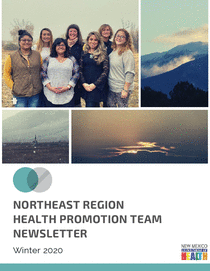 Health Promotion Newsletter – NE Region Winter 2020
Health Promotion - Newsletter
December 27, 2019
Health Promotion Newsletter – NE Region Winter 2020
Health Promotion - Newsletter
December 27, 2019
This issue’s themes focused on resiliency, inner strength, & magic.
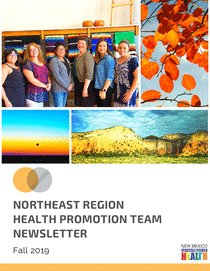 Health Promotion Newsletter – NE Region Fall 2019
Health Promotion - Newsletter
October 25, 2019
Health Promotion Newsletter – NE Region Fall 2019
Health Promotion - Newsletter
October 25, 2019
This issue’s themes focus on preparation, harvest, and reestablishing a setpoint.
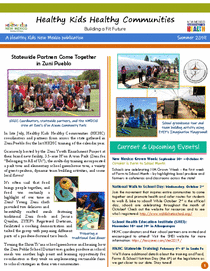 Healthy Kids Healthy Communities Newsletter – Summer-2019
Healthy Kids Healthy Communities - Newsletter
October 18, 2019
Healthy Kids Healthy Communities Newsletter – Summer-2019
Healthy Kids Healthy Communities - Newsletter
October 18, 2019
This newsletter provides a wealth of information about the Healthy Kids Healthy Communities program and related topics including healthy living tips, recent updates, community improvements, education system news, and more.
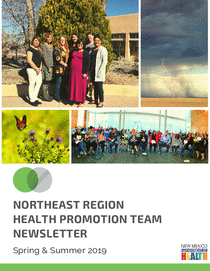 Health Promotion Newsletter – NE Region Spring/Summer 2019
Health Promotion - Newsletter
July 15, 2019
Health Promotion Newsletter – NE Region Spring/Summer 2019
Health Promotion - Newsletter
July 15, 2019
This issue’s theme covers growth, nourishment, and connection in our health promotion work in the communities we serve.
 Healthy Kids Healthy Communities Newsletter – Fall Winter 2018-2019
Healthy Kids Healthy Communities - Newsletter
March 4, 2019
Healthy Kids Healthy Communities Newsletter – Fall Winter 2018-2019
Healthy Kids Healthy Communities - Newsletter
March 4, 2019
This newsletter provides a wealth of information about the Healthy Kids Healthy Communities program and related topics including healthy living tips, recent updates, community improvements, education system news, and more.
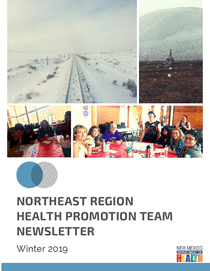 Health Promotion Newsletter – NE Region Winter 2019
Health Promotion - Newsletter
February 11, 2019
Health Promotion Newsletter – NE Region Winter 2019
Health Promotion - Newsletter
February 11, 2019
This issue’s theme covers personal and professional development pursuits of the Northeast Region Health Promotion Team.
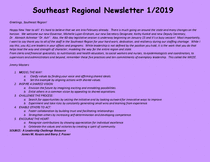 Health Promotion Newsletter – SE Region Winter 2019
Health Promotion - Newsletter
February 11, 2019
Health Promotion Newsletter – SE Region Winter 2019
Health Promotion - Newsletter
February 11, 2019
This issue’s theme covers personal and professional development pursuits of the Southeast Region Health Promotion Team.
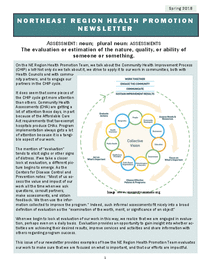 Health Promotion Newsletter – NE Region Spring 2018
Health Promotion - Newsletter
November 7, 2018
Health Promotion Newsletter – NE Region Spring 2018
Health Promotion - Newsletter
November 7, 2018
This is the Northeast Region Health Promotion Newsletter for the Spring of 2018.
 Health Promotion Newsletter – NE Region Winter 2017
Health Promotion - Newsletter
November 7, 2018
Health Promotion Newsletter – NE Region Winter 2017
Health Promotion - Newsletter
November 7, 2018
This is the Northeast Region Health Promotion Newsletter for the Winter of 2017.
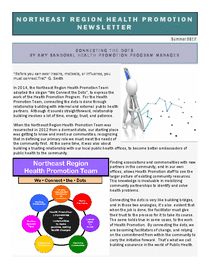 Health Promotion Newsletter – NE Region Summer 2017
Health Promotion - Newsletter
November 7, 2018
Health Promotion Newsletter – NE Region Summer 2017
Health Promotion - Newsletter
November 7, 2018
This is the Northeast Region Health Promotion Newsletter for the Summer of 2017.
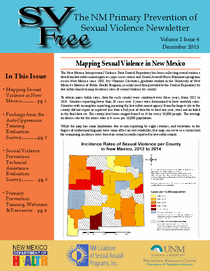 Sexual Violence Newsletter - December 2015
Sexual Violence Prevention - Newsletter
December 1, 2015
Sexual Violence Newsletter - December 2015
Sexual Violence Prevention - Newsletter
December 1, 2015
This monthly newsletter provides a wealth of information about sexual violence prevention in New Mexico.
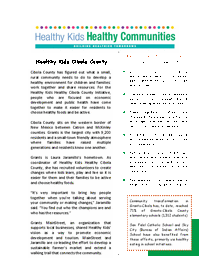 Success Stories of Cibola County
Healthy Kids Healthy Communities - Newsletter
March 19, 2014
Success Stories of Cibola County
Healthy Kids Healthy Communities - Newsletter
March 19, 2014
Cibola County has figured out what a small, rural community needs to do to develop a healthy environment for children and families: work together and share resources. For the Healthy Kids Healthy Cibola County Initiative, people who are focused on economic development and public health have come together to make it easier for residents to choose healthy foods and be active.
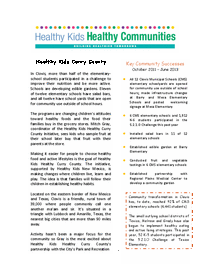 Success Stories of Curry County
Healthy Kids Healthy Communities - Newsletter
March 19, 2014
Success Stories of Curry County
Healthy Kids Healthy Communities - Newsletter
March 19, 2014
In Clovis, more than half of the elementary-school students participated in a challenge to improve their nutrition and be more active. Schools are developing edible gardens. Eleven of twelve elementary schools have salad bars, and all twelve have school yards that are open for community use outside of school hours.
 Success Stories of Guadalupe County
Healthy Kids Healthy Communities - Newsletter
March 19, 2014
Success Stories of Guadalupe County
Healthy Kids Healthy Communities - Newsletter
March 19, 2014
Katrina Velasquez is busy racking up miles. The first-grader is her family’s motivator too, pushing her parents to walk with her on their five-acre property a mile outside of Santa Rosa.
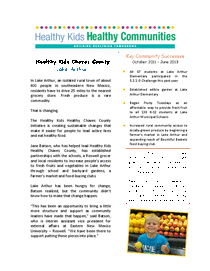 Success Stories of Lake Arthur
Healthy Kids Healthy Communities - Newsletter
March 19, 2014
Success Stories of Lake Arthur
Healthy Kids Healthy Communities - Newsletter
March 19, 2014
In Lake Arthur, an isolated rural town of about 400 people in southeastern New Mexico, residents have to drive 25 miles to the nearest grocery store. Fresh produce is a rare commodity.
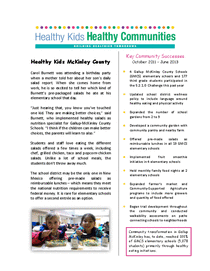 Success Stories of McKinley County
Healthy Kids Healthy Communities - Newsletter
March 19, 2014
Success Stories of McKinley County
Healthy Kids Healthy Communities - Newsletter
March 19, 2014
Carol Burnett was attending a birthday party when a mother told her about her son’s daily salad report. When she comes home from work, he is so excited to tell her which kind of Burnett’s pre-packaged salads he ate at his elementary school that day.
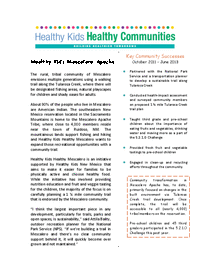 Success Stories of the Mescalero Apache Tribe
Healthy Kids Healthy Communities - Newsletter
March 19, 2014
Success Stories of the Mescalero Apache Tribe
Healthy Kids Healthy Communities - Newsletter
March 19, 2014
The rural, tribal community of Mescalero envisions multiple generations using a walking trail along the Tularosa Creek, where there will be designated fishing areas, natural playscapes for children and shady oases for adults.
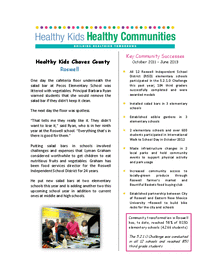 Success Stories of Roswell
Healthy Kids Healthy Communities - Newsletter
March 19, 2014
Success Stories of Roswell
Healthy Kids Healthy Communities - Newsletter
March 19, 2014
One day the cafeteria floor underneath the salad bar at Pecos Elementary School was littered with vegetables. Principal Barbara Ryan warned students that she would remove the salad bar if they didn’t keep it clean.
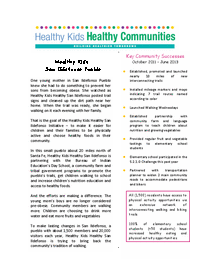 Success Stories of San Ildefonso Pueblo
Healthy Kids Healthy Communities - Newsletter
March 19, 2014
Success Stories of San Ildefonso Pueblo
Healthy Kids Healthy Communities - Newsletter
March 19, 2014
One young mother in San Ildefonso Pueblo knew she had to do something to prevent her sons from becoming obese. She watched as Healthy Kids Healthy San Ildefonso posted trail signs and cleaned up the dirt path near her home. When the trail was ready, she began walking on it each evening with her family.
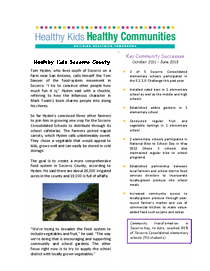 Success Stories of Socorro County
Healthy Kids Healthy Communities - Newsletter
March 19, 2014
Success Stories of Socorro County
Healthy Kids Healthy Communities - Newsletter
March 19, 2014
Tom Hyden, who lives south of Socorro on a farm near San Antonio, calls himself the Tom Sawyer of the food-system movement in Socorro. “I try to convince other people how much fun it is,” Hyden said with a chuckle, referring to how the infamous character in Mark Twain’s book charms people into doing his chores.


